|
Abstract
An amputation of the hand is a devastating injury. It adversely affects the victim’s ability to earn a livelihood, support a family, and carry out daily activities. It has a great psychological impact. We report a middle aged male with an amputation at the level of the distal forearm who underwent replantation. The operative details of this case are described. Awareness of the possibility of salvage should be spread among healthcare personnel and the need for immediate attention by a multispeciality team is advocated. This report reviews the literature related to the operative technique, contraindications and long term results.
Keywords: Replantation; Microvascular; Hand amputation.
Introduction
Replantation is defined as reattachment of the amputated limb using the neurovascular and musculoskeletal structures in order to obtain recovery of the limb. Since the first successful replantation of a human thumb reported by Komatsu and Tamai in 1968, thousands of severed digits and body parts have been successfully salvaged.1 The goal of replantation after traumatic amputation is successful salvage of the limb in both form and function.
The simple return of circulation to the distal part does not in itself define success. The technical steps involved include examination and dissection of the neurovascular structures, bone fixation, tendon and muscle repair followed by microsurgical artery, nerve and vein repair, and finally skin closure. The hand is placed in a splint and the patient is monitored closely for circulatory changes in the fingers during the post-operative period.
The decision to attempt salvage in such an injury has evolved and is influenced by many factors, including the importance of the part, level of injury, expected return of function, and mechanism of injury. The absolute contraindications to attempt salvage are existence of associated injuries or preexisting illnesses which may preclude transfer or a prolonged operation. Relative contraindications include vascular/nerve injuries at multiple levels and patients who are mentally unstable. Success rates are expected to be poor when there is a crush/avulsion injury as compared with a guillotine type of injury.
Functional outcomes following replantation vary with the level of injury. Replants of the fingers distal to the flexor superficialis insertion, the hand at the wrist, and the upper extremity at the distal forearm can achieve good function.2-4 Results are better in younger patients.
In this case report, we describe a middle aged male patient with an amputation at the level of distal forearm and the successful salvage of his hand by a multispecialty team.
Case Report
A 46 year old right handed male patient sustained an injury when his dominant hand was caught in a block cutting machine he was working on. A bandage and splint was applied and he was rushed to the A&E where he arrived within 1 hour of the injury. He was conscious, oriented, appeared pale and had a BP of 90/60 mm Hg. His right forearm stump showed evidence of crush injury, (Fig 1). The amputated hand was brought in a polythene bag placed inside a plastic box filled with ice. (Figs. 2,3)
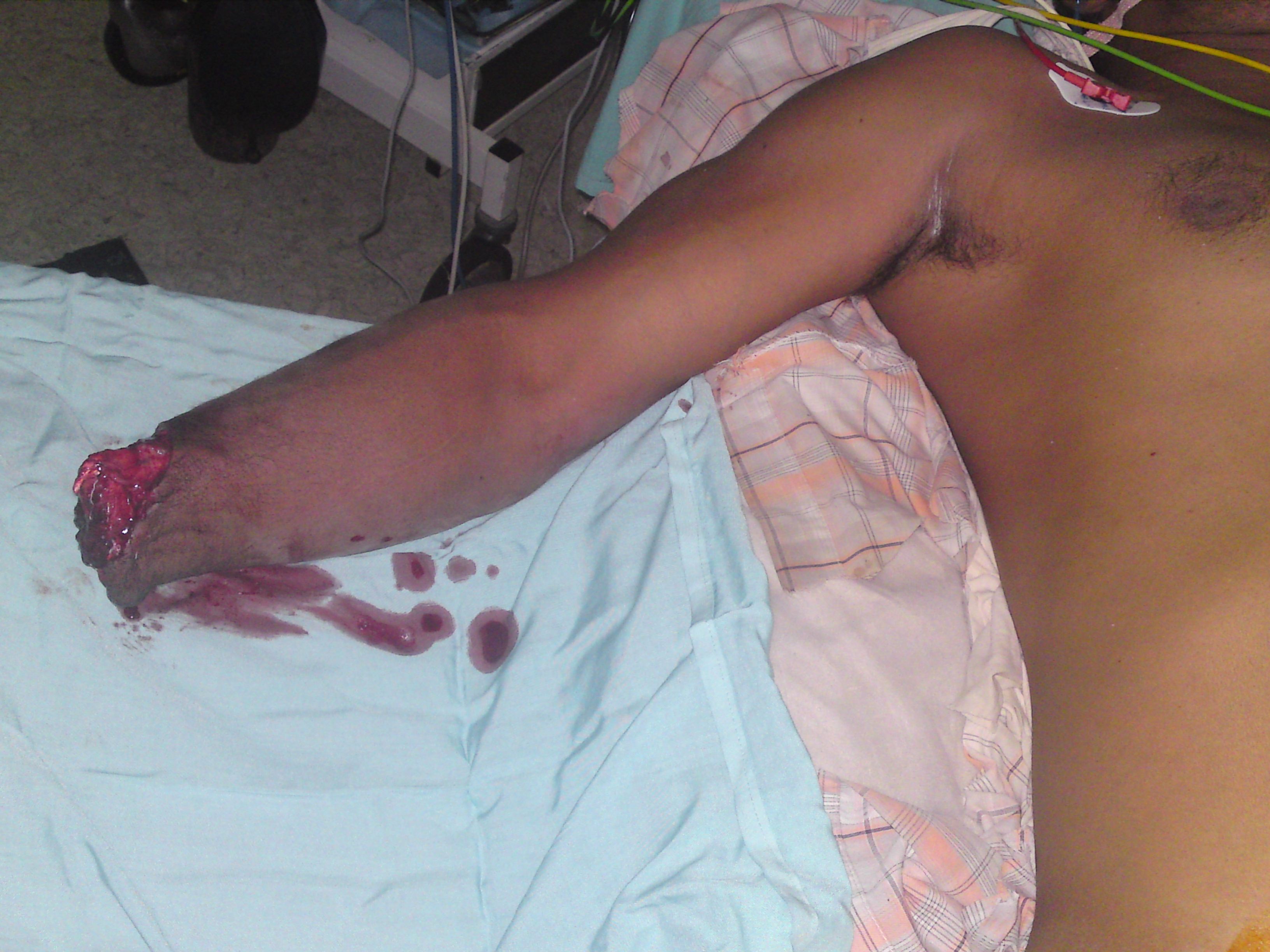
Figure 1: Forearm stump.
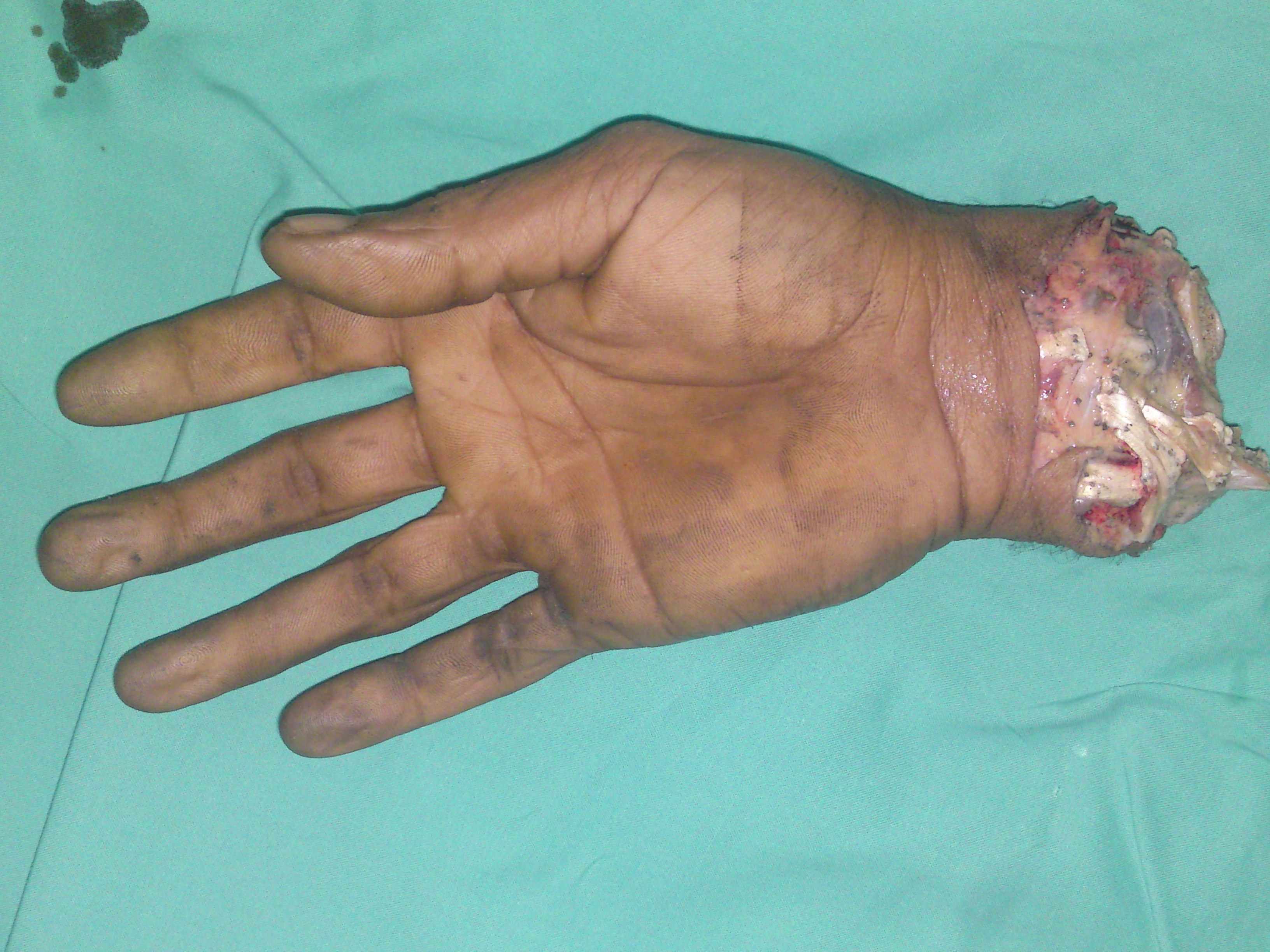
Figure 2: Amputated hand volar.
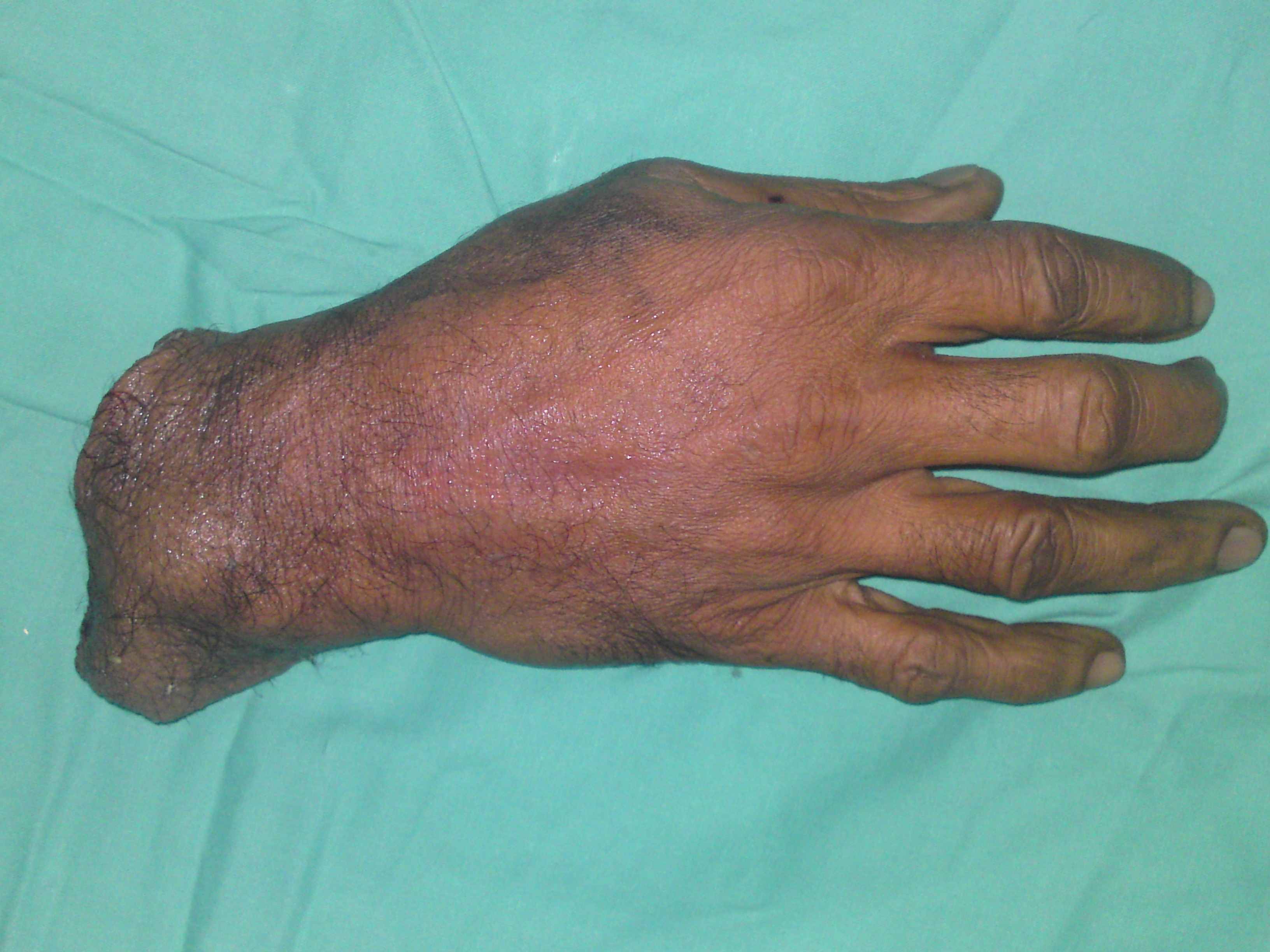
Figure 3: Amputated hand dorsum.
The patient was resuscitated and X-rays were obtained which showed an amputation of both the radius and the ulna in the distal third. The amputated hand was washed thoroughly with 4 litres of NS and carefully examined. A decision to attempt salvage was taken jointly with the orthopedic team and the consent was obtained from the patient after explaining the pros and cons and he was taken up for surgery immediately under GA. The raw area on the amputated hand was covered with saline soaked gauze and placed in sterile polythene, which was kept in an ice box for transfer to the OT.
Bench surgery was performed on the amputated part by one team while the patient was being prepared for induction. It involved shortening of both bones by about 1.5 cm, debridement of the crushed tissues, and tagging of the arteries, veins and nerves. Ice packs were kept in the vicinity of the part until the vascular continuity was established.
The stump was prepared by shortening of both bones by 1 cm, debridement of the crushed tissues, and tagging of the arteries, veins and nerves. A 3 mm K wire was passed through both the radius and the ulna. Additional interosseous wires were passed for improved stability. The ulnar and radial arteries were freshened and good bleed was confirmed. The ulnar artery repair was done and good backflow from the distal radial artery was observed. Arterial input was established around 4 hours following the injury. The tourniquet was now elevated and subsequent repairs of the median nerve, ulnar nerve, radial artery, and three veins - two on the dorsum and one on the volar aspect were carried out. All vascular anastomoses were done with 10-0 nylon under the operating microscope (Zeiss Opmi Vario). A distal incision through the thenar crease helped identify the distal structures and also served for carpal tunnel release. The tourniquet was periodically deflated to stay within the safe time limits. The tendons were repaired individually or mass repaired expeditiously to avoid undue delay. The surgery lasted eight hours and the patient recovered from anaesthesia uneventfully.
The patient received a single dose of low molecular weight heparin intraoperatively, platelet inhibitor dipyridamole and aspirin for two weeks postoperatively. Antibiotics were also given for two weeks. His vitals, urine output and hand vascularity were monitored closely. All wounds healed and the patient was discharged after three weeks, (Figs. 4,5). At discharge, there was a flicker of movement in the fingers. The patient was advised on the need for regular follow up to assess the bony union, range of motion and nerve recovery. Further procedures that may be required for the tendons including repair/tenolysis/transfers, neurolysis for the nerves, selective arthrodeses and prolonged physiotherapy during the next 1 year have been explained to the patient.
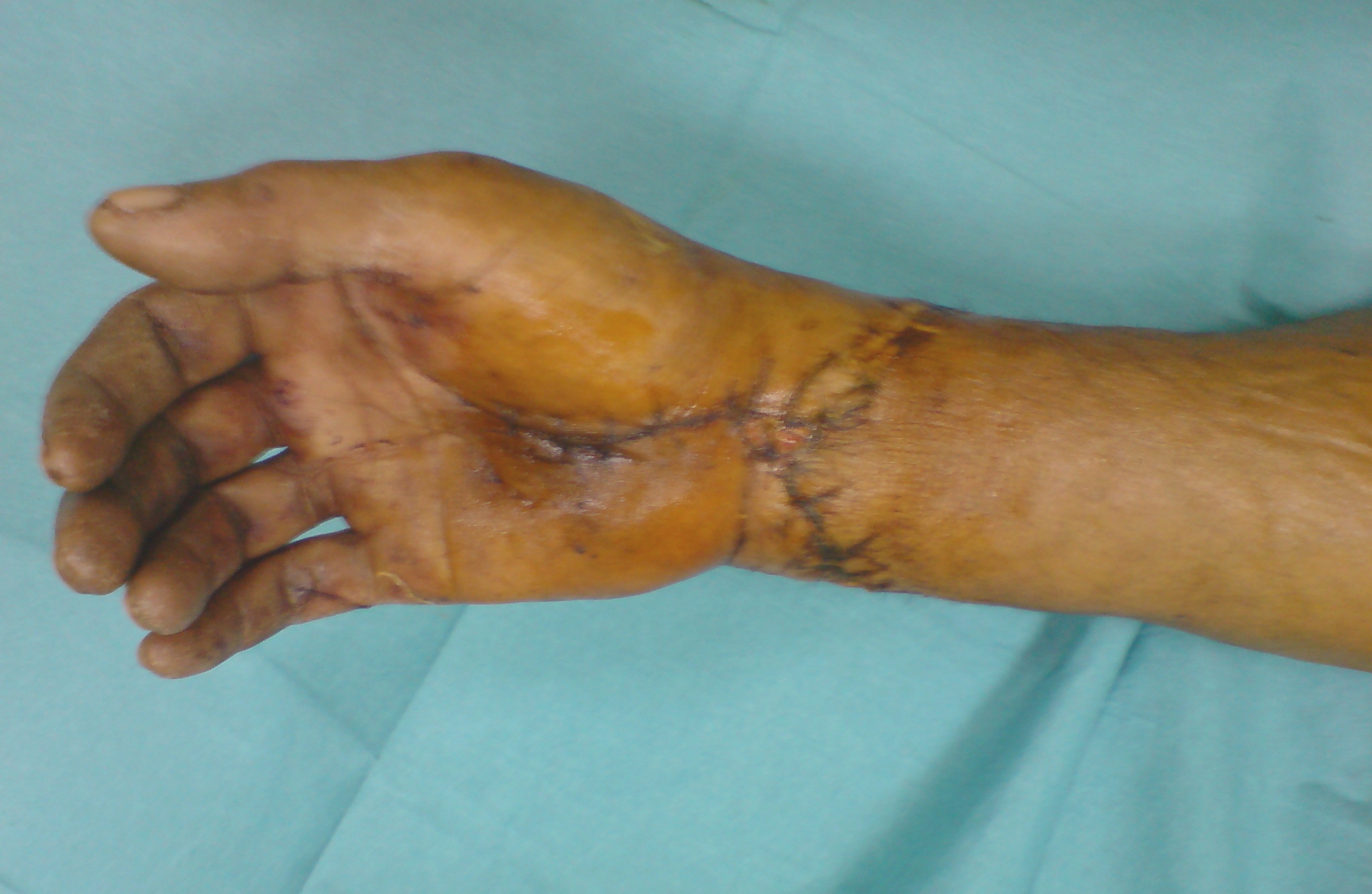
Figure 4: Replanted hand volar.
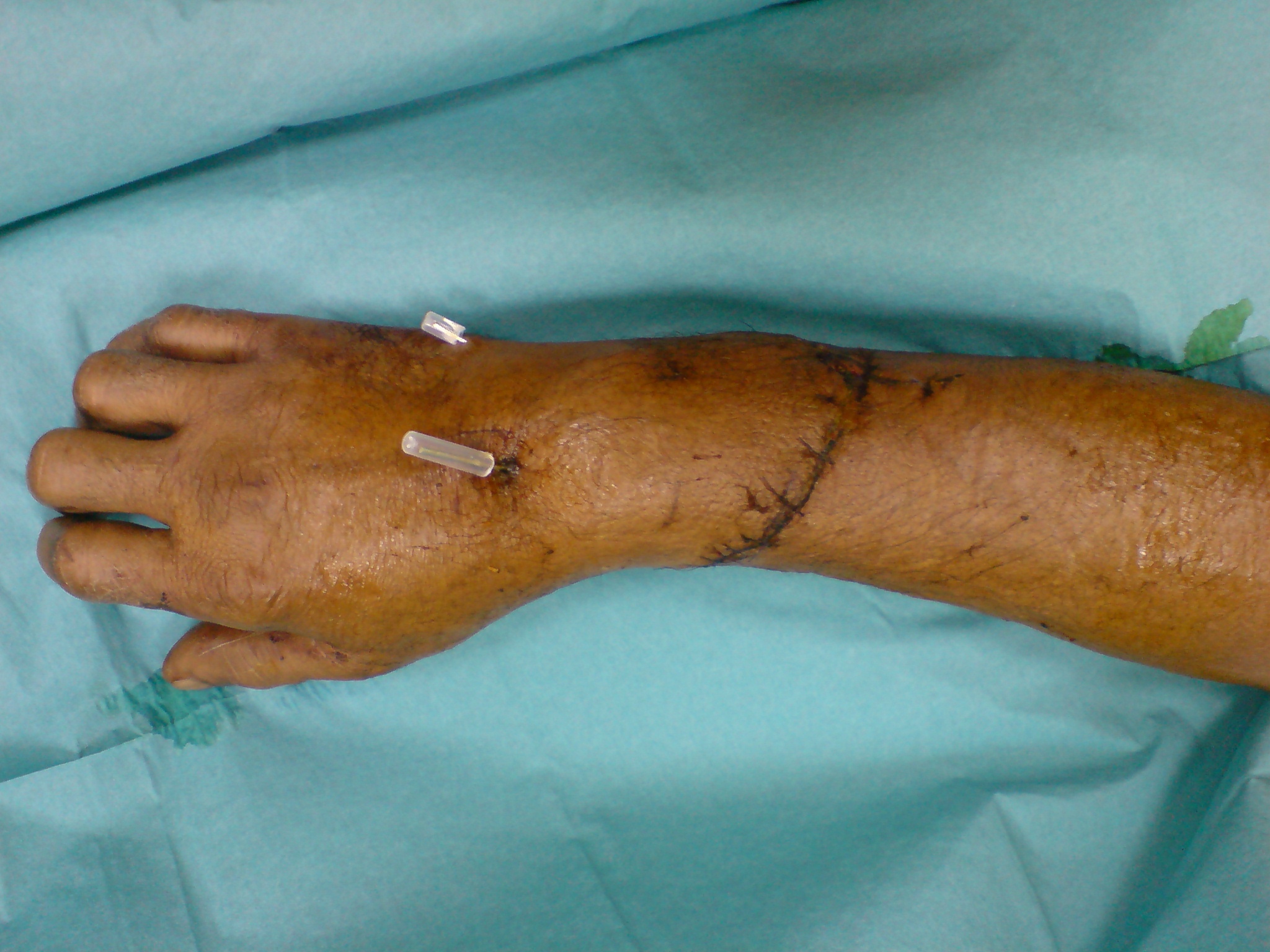
Figure 5: Replanted hand dorsum.
Discussion
The goal of replantation after a traumatic amputation is successful salvage of the limb in both form and function. Various recommendations have crystallized from the experience in large series. When transferring the patient, ice placed in plastic bags should be placed in the vicinity of the distal part to reduce warm ischemia time. When the distal part is connected with a small bit of tissue it may be better to cut it off and the severed part should then be transported carefully. The severed part is to be covered with gauze moistened with saline, kept in a plastic bag and then placed in ice. Bleeding vessels in the stump should not be clamped and should be managed by compressive dressings and limb elevation.
The upper limit of ischemia times for major injuries from the level of shoulder to the wrist are 6 hours of warm and 12 hours of cold ischemia, although occasionally success has been reported after longer ischemia times.5 Reduction in ischemia time may be achieved by placing a shunt between the proximal and distal vessels while the patient is being prepared for surgery. Complete vascular washout with University of Wisconsin solution at 4⁰C into the artery has been shown to improve results.6
Preoperative preparation includes fluid resuscitation and warming to prevent vasoconstriction. Incisions are made to identify neurovascular structures which are carefully tagged and protected during the bony manipulations. Bone shortening is recommended to reduce the tension across the neurovascular repairs and for ease of soft tissue closure. Bone should be shortened on the amputated part and not the stump so as to retain the length should the operation fail. K-wires are placed commonly to fix the fracture.
The arterial flow is assessed after deflating the tourniquet. If the proximal vessel spurt is inadequate additional vessel shortening may be required. The order of repair of various structures depends on the surgeon preference and the specific clinical situation. A vein graft may be harvested from the contralateral arm or leg and should be reversed for arterial interposition. The aim should be to repair at least one artery and two veins. After revascularization, it is essential to observe the vascularity of the muscles and carry out further debridement of muscles, if necessary.7
Postoperative care includes adequate fluids and warming the patient’s room to prevent hypotension and vasospasm. There are reports recommending the use of aspirin, dextran or heparin, however none are backed by a randomized control trial.8,9 The patient’s hand is monitored closely for signs of arterial insufficiency or venous congestion. Both situations often merit an urgent re-exploration and revision of the affected anastomosis.
During the postoperative period systemic reperfusion problems may present as myoglobunuria, tachypnoea, and signs of acute respiratory distress syndrome. Amputation in such an eventuality may be life saving and should be performed as early as possible if the patient shows progressive symptoms of reperfusion syndrome.7
The outcome of surgery has to be assessed not only by the rate of limb survival but also by the functional result and patient acceptability. Most large series are a combination of patients who underwent replantation or revascularization.
In reviewing the large volume retrospective reports, the limb survival rates range from 82% in North Carolina to 100% in Ogori Daiichi Hospital, Japan.10,11 Long term outcomes are commonly evaluated using various scoring systems which are based on early professional readaptation, the extent of joint restriction, sensory recovery and muscle power. Lutz reported a series of 64 patients who underwent successful hand and digit replantation/ revascularization for salvage after crush injuries. The average follow up in his series was around 12 years and secondary procedures were necessary in 45% of the study population.12 While Russell et al. published one of the largest review regarding major limb replantations, they stated that 22 of 24 patients were satisfied with the function and appearance of their replanted part.3 A recent retrospective series with an 11 year mean follow up reports revealed that the results were very good or good in 65%, moderate in 11%, and poor in 23%. The outcomes were worse when the amputation was at or above the elbow level and when associated with avulsion.13
Conclusion
The field of replantation has become sophisticated over the last four decades. Awareness of the possibility of salvage should be spread among healthcare personnel. Timely intervention at every stage will help reduce ischemia time and thus improve the survival rates and the long term functional outcomes. The patient may need further surgeries and requires prolonged physiotherapy. With a committed patient and a dedicated team, we are hopeful of a good functional outcome. The success has been a morale booster for the entire team.
Acknowledgements
The authors reported no conflict of interest and no funding was received on this work
|